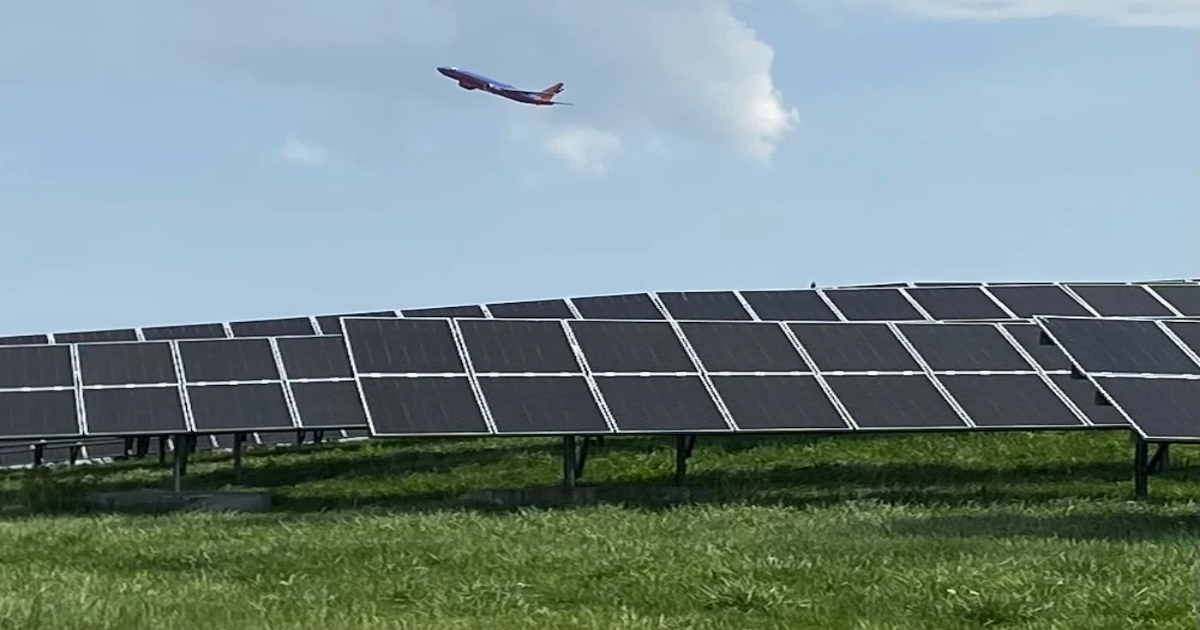A SOUTHWEST PLANE FLIES OVER THE 10,000 SOLAR PANELS AT PITTSBURGH INTERNATIONAL AIRPORT. THE SOLAR FIELD WILL MORE THAN DOUBLE IN SIZE BY 2027. | PHOTO BY VIRGINIA LINN
When a power outage shut down London Heathrow Airport in March for most of a day, more than 1,300 flights were canceled, disrupting travel for 200,000 passengers.
That won’t happen at Pittsburgh International Airport.
That’s because the airport is totally powered by its own 23-megawatt microgrid project on-site with a natural gas plant as well as 10,000 solar panels on 8 acres constructed over a landfill.
Airport and business officials on Tuesday announced they are more than doubling that solar capacity with expansion of 11,216 high-efficiency solar panels. That construction should be completed by 2027.
“When you lose access to energy production, you actually have to stop airports from functioning properly,” Airport CEO Christina Cassotis said as she stood before the solar field. “We will never have that problem. And I’m really excited that this actually strengthens our microgrid. It strengthens our commitment to energy independence and energy diversity here at the airport.”
When the latest project is completed, the solar panels will span over 20 acres of landfill, property that can’t be used for any other purpose. The first phase was built by IMG Energy Solutions, which has since merged with the Denver-based Liberty Energy. In the new phase, the partnership includes Duquesne Light Co., marking its first power purchase agreement with the airport.
The original 8 acres generate 3 megawatts of clean energy; the addition will add 4.7 megawatts — for a total of 7.7 megawatts. And because of advances in technology since the first phase was built four years ago, each new, denser solar panel can produce nearly 600 watts, instead of the 390 watts in the panels on-site now.
MIKE BRADY OF LIBERTY ENERGY TALKS ABOUT THE SOLAR PANELS AT PITTSBURGH INTERNATIONAL AIRPORT. | PHOTO BY VIRGINIA LINN
“So with the acreage that we have, we can get a lot more power than we were able to get in phase one,” said Mike Brady, former IMG CEO and vice president of power generation at Liberty Energy.
Despite that, he said the first phase has exceeded his expectations in energy generation.
Because of Pittsburgh’s cloud cover, he said, the panels on average are generating power 18% of the time (vs. an area without clouds like Arizona that might generate power up to 100% in daylight). Still, the PIT field generates enough energy, combined with the natural gas plant on the other side of the airport property, to operate the airport, he said.
One challenge facing the project, however, is the possible high tariffs. The panels in the first phase were produced in Vietnam, he said. While his company is trying to source the newer panels in the United States, there aren’t enough production facilities here to handle demand. Most of the world’s solar panels are produced in Vietnam, Cambodia, Laos and Malaysia, he said.
Cassotis said PIT’s microgrid has been drawing international attention, especially in the wake of the recent outages in London, as well as in Spain and Portugal. “This is a big deal. It’s a big deal for the community to celebrate and to recognize that we’re leading the way on a global stage.”


